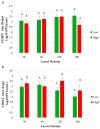Does Nutrient Availability and Larval Competition Alter Chikungunya Virus Infection in the Mosquito Aedes albopictus?
- PMID: 40431625
- PMCID: PMC12115553
- DOI: 10.3390/v17050613
Does Nutrient Availability and Larval Competition Alter Chikungunya Virus Infection in the Mosquito Aedes albopictus?
Abstract
Aedes albopictus is a mosquito that has spread rapidly in the United States and is considered an important vector for arbovirus transmission to humans in several countries. Larval interactions and environmental conditions can influence mosquitoes and their ability to transmit pathogens as adults. We investigated whether intraspecific larval competition among Ae. albopictus mosquitoes from Florida, combined with varying food availability, affects vector competence for Chikungunya virus (CHIKV). We reared larvae under four competition treatment densities and two food levels. Measurements were taken for larval development duration, survival rate, and female wing length. Mosquitoes from each treatment group were orally challenged with CHIKV. Our results showed that development time was longer for both female and male Ae. albopictus under high-competition conditions and appeared as the most important factor, followed by survivorship. Survival rates were highest under low-density conditions compared to those reared under high-density conditions. Mosquitoes reared with a low amount of food had the lowest survivorship and longest development times compared to those provided with high food levels. Our results also showed susceptibility infection and disseminated infection of CHIKV was influenced by an interaction of density and food availability. Mosquitoes from the high-food, high-density treatment group exhibited lower CHIKV infection and dissemination rates compared to other treatment combinations. These findings highlight the role of larval competition and nutritional stress during immature stages in shaping adult mosquito traits, with important epidemiological implications for CHIKV transmission.
Keywords: Aedes albopictus; Chikungunya virus; intraspecific larval competition; nutrient availability; susceptibility to infection.
Conflict of interest statement
The authors declare no conflict of interest.
Figures





References
-
- Hawley W.A. The biology of Aedes albopictus. J. Am. Mosq. Control Assoc. Suppl. 1988;1:1–39. - PubMed
-
- Barrera R. Competition and resistance to starvation in larvae of container-inhabiting Aedes mosquitoes. Ecol. Entomol. 1996;21:117–127. doi: 10.1111/j.1365-2311.1996.tb01178.x. - DOI
-
- Mitchell C.J. Geographic spread of Aedes albopictus and potential for involvement in arbovirus cycles in the Mediterranean basin. J. Vector Ecol. 1995;20:44–58.
-
- Resck M.E.B., Câmara D.C.P., Dos Santos F.B., Dos Santos J.P.C., Alto B.W., Honório N.A. Spatial-temporal distribution of chikungunya virus in Brazil: A review on the circulating viral genotypes and Aedes (Stegomyia) albopictus as a potential vector. Front. Public Health. 2024;12:1496021. doi: 10.3389/fpubh.2024.1496021. - DOI - PMC - PubMed
Publication types
MeSH terms
Supplementary concepts
Grants and funding
LinkOut - more resources
Full Text Sources
Medical

